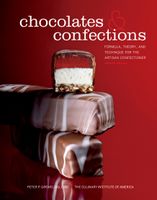Advertisement
Invert Sugar
By Peter Greweling and Culinary Institute of America
Published 2007
Invert sugar is made by splitting disaccharide sucrose into its two component monosaccharides, fructose (also known as levulose) and dextrose (also known as glucose). (See Inversion.) Commercially, inversion may be accomplished by exposing disaccharide sucrose to an acid, usually hydrochloric acid, or treating it with the enzyme invertase. Invert sugar is valued by confectioners for its doctoring capacity, which is its most common function in confectionery formulation. It is sweeter than sucrose, more hygroscopic and, unlike sucrose, it readily contributes to Maillard browning. (See Maillard Reaction.) Because sucrose alone is soluble only to approximately 67 percent at room temperature, and invert sugar is soluble to approximately 80 percent, invert sugar is frequently added to sugar confectionery to increase the dissolved-solids content, lower water activity, and extend shelf life. Invert sugar is most commonly found as a creamy liquid paste containing approximately 80 percent solids.



